
Radha, also called Radhika, is a Hindu goddess and the chief consort of the god Krishna. She is the goddess of love, tenderness, compassion, and devotion. In scriptures, Radha is mentioned as the avatar of Lakshmi and also as the Mūlaprakriti, the Supreme goddess, who is the feminine counterpart and internal potency of Krishna. Radha accompanies Krishna in all his incarnations. Radha's birthday is celebrated every year on the occasion of Radhashtami.

Mathura is a city and the administrative headquarters of Mathura district in the Indian state of Uttar Pradesh. It is located 57.6 kilometres (35.8 mi) north of Agra, and 146 kilometres (91 mi) south-east of Delhi; about 14.5 kilometres (9.0 mi) from the town of Vrindavan, and 22 kilometres (14 mi) from Govardhan. In ancient times, Mathura was an economic hub, located at the junction of important caravan routes. The 2011 Census of India estimated the population of Mathura at 441,894.
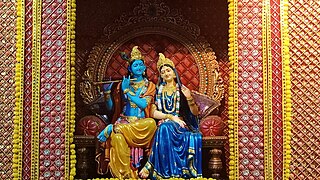
Braj, also known as Vraj, Vraja, Brij or Brijbhumi, is a region in India on both sides of the Yamuna river with its centre at Mathura-Vrindavan in Uttar Pradesh state encompassing the area which also includes Palwal, Ballabhgarh and Nuh in Haryana state, Deeg, Bharatpur, Karauli, and Dholpur in Rajasthan state and Morena District in Madhya Pradesh. Within Uttar Pradesh, it is very well demarcated culturally, the area stretches from the Mathura, Aligarh, Agra, Hathras and districts up to the Etah district. Braj region is associated with Radha and Krishna who according to scriptures were born in Barsana and Mathura respectively. It is the main centre of Krishna circuit of Hindu pilgrimage.

Vrindavan, also spelt Vrindaban and Brindaban, is a historical city in the Mathura district of Uttar Pradesh, India. It is located in the Braj Bhoomi region and holds religious importance for Hindus who believe that Krishna, one of the main Gods in Hinduism, spent most of his childhood in this city. Vrindavan has about 5,500 temples dedicated to the worship of Krishna and his chief consort, Radha. It is one of the most sacred places for Vaishnava traditions.
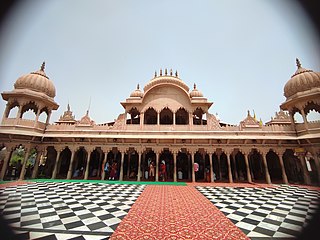
Barsana is a historical town and nagar panchayat in the Mathura district of the state of Uttar Pradesh, India. The town holds cultural and religious significance as the birthplace of Hindu goddess Radha, the chief consort of Krishna. Barsana is situated in the Braj region. The main attraction of the town is the historical Radha Rani Temple which attracts huge number of devotees throughout the year.

Parikrama or Pradakshina is clockwise circumambulation of sacred entities, and the path along which this is performed, as practiced in the Indic religions – Hinduism, Buddhism, Sikhism and Jainism. In Buddhism, it refers only to the path along which this is performed. In Indic religions, the parikrama is typically done after completion of traditional worship and after paying homage to the deity. Parikrama must be done with dhyāna.

Radha Kund is a town and nagar panchayat in Mathura district in the Indian state of Uttar Pradesh. It is also one of the pilgrimage sites dedicated to Hindu goddess Radha.
Vraja Mandal Parikrama, also called VrajaYatra, is a Nimbarka Sampradaya Hindu pilgrimage dedicated to Krishna. At present Vraja Parikrama Pradhan Mahant Sri Sri 108 Swami Rasbiharidas Kathiababaji Maharajji of 84 kos Vraja region (Braja) which takes 1 to 2 months depending on the route and speed of travel on foot. The Nimbarka Sampradaya tradition Vaishnava Nagaji Maharaj only performed 84 crore Vraja Parikrama 530 years ago. Since this is a site associated with Krishna and the Mahabharata, it is an important place of pilgrimage for Hindus. It is one of 3 main pilgrimage sites related to the Krishna circuit, namely the 48 kos parikrama in Haryana, Braj parikarma in Mathura in Uttar Pradesh, and Dwarkadhish temple pilgrimage in Gujarat.
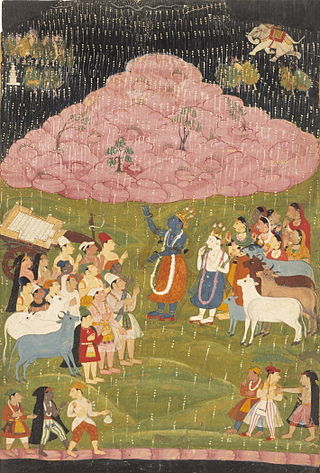
The Govardhana Shila is a rock from the Govardhana Hill in Braj, Uttar Pradesh, India. Govardhan Hill holds a unique position in Hindu scriptures related to Krishna, the land called Braj where He was born. Known as Govardhan or Giriraj and being the sacred centre of Braj, it is identified as a natural form of Krishna. Indian art overwhelmingly prefers the iconic image, but some aniconism does occur in folk worship, early Buddhism, Shiva's Banalinga, and Vishnu's Shaligrama). They have solar significance, and their use in worship predates the Hindu period in India. The stone is usually brown in colour.

Lalita, also commonly called Lalita Sakhi, is the Hindu goddess and one of the most prominent associates of the divine couple Radha Krishna. In many Vaishnaite traditions and literatures, she is revered as the gopi (milkmaid) of the Braj region and is mentioned as the chief of Ashtasakhi, the eight closest eternal companion of Radha and Krishna.

The Culture of Uttar Pradesh is an Indian culture which has its roots in Hindi, Bhojpuri and Urdu literature, music, fine arts, drama and cinema. Lucknow, the capital of Uttar Pradesh, has historical monuments including Bara Imambara and Chhota Imambara, and has preserved the damaged complex of the Oudh-period British Resident's quarters, which are being restored.

Situated in the northern part of India, bordering with the capital of India New Delhi, Uttar Pradesh is one of the most popular and an established tourist destination for both Indians and non-Indians alike in India. The most populous state of India, Uttar Pradesh contains many historical monuments and places of religious significance. Geographically, Uttar Pradesh is very diverse, with Himalayan foothills in the extreme north and the Gangetic Plain in the centre. It is also home of India's most visited sites, Hinduism's holiest city, Varanasi. Kumbh city, Prayagraj. Kathak, one of the eight forms of Indian classical dances, originated from Uttar Pradesh. Uttar Pradesh is at the heart of India, hence it is also known as The Heartland of India. Cuisine of Uttar Pradesh like Awadhi cuisine, Mughlai cuisine and Bhojpuri cuisine are very famous not only in India but also many places abroad.

ISKCON Vrindavan, also called Sri Krishna Balaram Mandir, is one of the major ISKCON temples in the world. It is a Gaudiya Vaishnava temple located in the city of Vrindavan, Mathura district, in the Indian state of Uttar Pradesh. The temple is dedicated to the Hindu gods Krishna and Balarama. The other deities of temple are Radha Krishna and Gauranga Nityananda.
Bera or Badrivan Dham is a village or gram panchayat in Nauhjhil Block, Mat Tehsil of Mathura district, Uttar Pradesh, India. It situated on Khair-Tentigaon Road. Bera village is about 50 kilometres from Mathura and only 17 kilometres from Khair.
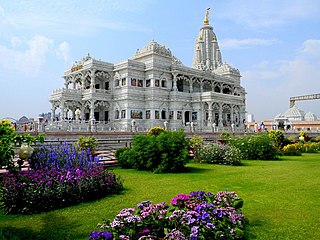
Prem Mandir is a Hindu temple in Vrindavan, Mathura district, Western Uttar Pradesh, India. The temple was established by Jagadguru Shri Kripalu Ji Maharaj. It is maintained by Jagadguru Kripalu Parishat, an international non-profit, educational, spiritual, charitable trust. The complex is on a 22-hectare (55-acre) site on the outskirts of Vrindavan. It is dedicated to Radha Krishna and Sita Ram. Radha Krishna are on the first level and Sita Ram are on the second level. Different Leelas of Shri Krishna and Rasik saints are depicted all over the wall of the main temple.

Shri Radha Rani Temple, is a historical Hindu temple, located in Barsana in Mathura district, Uttar Pradesh, India. The temple is dedicated to the goddess Radha. The main deities of the temple are Radha Krishna who are worshiped together in the form of Shri Laadli Lal, which means the beloved daughter and son of the town.

Radha Krishna Vivah Sthali is a Hindu temple, dedicated to Radha and Krishna. The temple site is present in the Bhandirvan forest of Mant constituency in Mathura district, Uttar Pradesh, India. The site holds cultural importance as according to Sanskrit scriptures - Braham Vaivarta Purana and Garga Samhita, Radha and Krishna were married in Bhandirvan forest in the presence of Brahma, the creator, who also became the priest and solemnized their wedding ceremony. Annually, this divine wedding is celebrated on the occasion of Phulera Dooj which usually falls in the month of February - March.

Shri Radha Madan Mohan Temple, is a Hindu temple situated in Vrindavan of Indian state of Uttar Pradesh. It is one of the oldest and highly revered temple of Vrindavan. The presiding deity of the temple is Madan Mohan, a form of the god Krishna who is present in the central altar of the temple with his consort goddess Radha and Lalita gopi on either sides of him. The temple is one of the earliest temples of Vrindavan which has architectural influences from existing Mughal architecture and as well as Kalinga Nagara Style of Indian Temple Architecture.

Shri Radha Vallabh Temple, also called Shri Radha Vallabhlal ji Temple is a historic temple in the city of Vrindavan, Mathura district, Uttar Pradesh, India. The temple is dedicated to Hindu deities Radha Krishna. The temple belongs to Radha Vallabh Sampradaya and was constructed in 16th century under the guidance of Vrindavan saint Hith Harivansha Mahaprabhu.

The Ashtasakhi are a group of eight prominent gopis and close associates of the Hindu deities Radha-Krishna in the Braj region. In many sub-traditions of Krishnaism, they are revered as goddesses and consorts of Krishna. According to the Padma Purana, the Ashtasakhi are the eternal female companions of Radha and Krishna in the Dvapara Yuga, with whom they descended upon the earth from their celestial abode of Goloka.



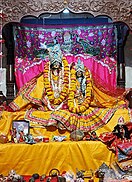
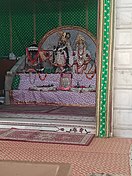








![According to Hindu mythology, Potra Kund (water body) was used to clean Krishna's baby clothes [Potre]. Potra Kund temple tank near Krishna Janmabhoomi Potra Kund.jpg](http://upload.wikimedia.org/wikipedia/commons/thumb/6/62/Potra_Kund.jpg/300px-Potra_Kund.jpg)




















